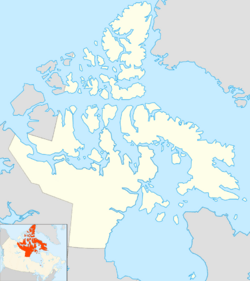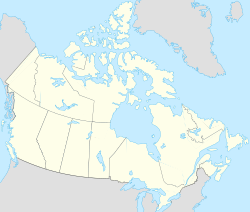Gilmour Island facts for kids
| Geography | |
|---|---|
| Location | Hudson Bay |
| Coordinates | 59°47′59″N 80°1′59″W / 59.79972°N 80.03306°W |
| Archipelago | Ottawa Islands Arctic Archipelago |
| Area | 84 km2 (32 sq mi) |
| Coastline | 53 km (32.9 mi) |
| Highest elevation | 549 m (1,801 ft) |
| Administration | |
|
Canada
|
|
| Nunavut | Nunavut |
| Region | Qikiqtaaluk |
| Demographics | |
| Population | Uninhabited |
| Source: Gilmour Island at Atlas of Canada | |
Gilmour Island is a quiet, empty island located in the Qikiqtaaluk Region of Nunavut, Canada. When we say "empty" or "uninhabited," it means no people live there permanently. This island is one of 24 islands that form the Ottawa Islands. You can find it in the eastern part of Hudson Bay. The highest point on Gilmour Island reaches over 549 meters (about 1,800 feet) above sea level.
Contents
Discovering Gilmour Island
Gilmour Island is a fascinating place, even though no one lives there. It's a part of Canada's vast northern lands. Learning about such islands helps us understand the geography of our world.
Where is Gilmour Island?
Gilmour Island is in Nunavut, which is a large territory in northern Canada. It's part of the Qikiqtaaluk Region, one of Nunavut's three main areas. The island sits in Hudson Bay, a huge body of saltwater in Canada. This bay is famous for its cold waters and unique wildlife.
Part of the Ottawa Islands
Gilmour Island is one of the 24 islands that make up the Ottawa Islands. This group of islands is located in the eastern part of Hudson Bay. They are known for their rugged beauty and remote locations.
What's Gilmour Island Like?
Gilmour Island is quite large, covering about 84 square kilometers (32 square miles). Its coastline stretches for 53 kilometers (33 miles). The island's highest point is a hill or mountain that rises 549 meters (1,800 feet) high. Imagine standing on top and looking out over the vast Hudson Bay!
Nearby Islands
Gilmour Island isn't alone in this part of Hudson Bay. There are several other islands close by. These include Booth Island, Bronson Island, Eddy Island, J. Gordon Island, Pattee Island, and Perley Island. Each of these islands contributes to the unique landscape of the Ottawa Islands.



